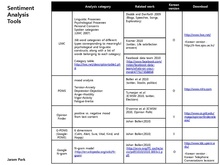Analisi del sentiment: differenze tra le versioni
Etichetta: Link a wikipedia.org |
|||
| Riga 94: | Riga 94: | ||
== Sentiment analysis e Web 2.0 == |
== Sentiment analysis e Web 2.0 == |
||
{{...}} |
{{...}} |
||
== Risorse di analisi del sentiment ==<!-- Please respect alphabetical order --> |
|||
VOcabolari sentiment e parole: |
|||
*Affective Norms for English Words (ANEW)<ref>{{cite web|url=https://tomlee.wtf/2010/06/16/anew/|title=generating the Affective Norms for English Words (ANEW) dataset|work=tomlee.wtf}}</ref><ref>{{Cite journal|title = Characterization of the Affective Norms for English Words by discrete emotional categories|url = http://link.springer.com/article/10.3758/BF03192999|journal = Behavior Research Methods|date = 2007-11-01|issn = 1554-351X|pages = 1020–1024|volume = 39|issue = 4|doi = 10.3758/BF03192999|first = Ryan A.|last = Stevenson|first2 = Joseph A.|last2 = Mikels|first3 = Thomas W.|last3 = James}}</ref> |
|||
*SenticNet<ref name="sentic.net"/><ref name="Cambria10" /> |
|||
*SentiWordNet<ref name="Esuli06" /><ref>{{cite web|url=http://sentiwordnet.isti.cnr.it/|title=SentiWordNet|work=cnr.it}}</ref> |
|||
*WordNet-Affect<ref name="Strapparava04" /><ref>{{cite web|url=http://wndomains.fbk.eu/wnaffect.html|title=WordNet Domains|author=Manuela Speranza, FBK|work=fbk.eu}}</ref> |
|||
Analizzatori di sentiment: |
|||
* AlchemyAPI<ref>http://www.alchemyapi.com/</ref> (commercial) |
|||
* BitextAPI<ref>https://www.bitext.com/</ref> (commercial) |
|||
* Semantria<ref>{{cite web|url=http://www.semantria.com/demo|title=Semantria Web Demo - semantria.com|work=semantria.com}}</ref> (commercial) |
|||
* Sentiment140<ref>{{cite web|url=http://help.sentiment140.com/api|title=API - Sentiment140 - A Twitter Sentiment Analysis Tool|work=sentiment140.com}}</ref> (commercial, for Twitter) |
|||
* Stanford NLP<ref>{{cite web|url=http://nlp.stanford.edu/sentiment/|title=Recursive Deep Models for Semantic Compositionality Over a Sentiment Treebank|work=Deeply Moving: Deep Learning for Sentiment Analysis}}</ref> (academic) |
|||
* Twinword<ref>{{cite web|url=https://www.twinword.com/api/sentiment-analysis.php?utm_source=en.wikipedia.org&utm_medium=wikiarticle&utm_campaign=sentimentanalysis|title=Twinword Sentiment Analysis API Web Demo|work=twinword.com}}</ref> (commercial, free / unlimited) |
|||
* Werfamous<ref>{{cite web|url=http://werfamous.com|title=A Twitter and web sentiment analysis tool|work=werfamous.com}}</ref> (free) |
|||
* WordStat<ref>{{cite web|url=http://provalisresearch.com/products/content-analysis-software/wordstat-dictionary/sentiment-dictionaries|title=Content analysis software for sentiment analysis|work=provalisresearch.com}}</ref> (commercial) |
|||
* Buzzlogix<ref>{{Cite web|title = Text Analysis & Sentiment Analysis API {{!}} Buzzlogix|url = http://www.buzzlogix.com/text-analysis|website = Buzzlogix {{!}} Text Analysis API|publisher = Buzzlogix.com|accessdate = 2015-11-23|language = en-US}}</ref> (free and commercial versions) |
|||
Annotated corpora (documents with manual annotations of sentiment that can be used to evaluate algorithms): |
|||
* Twitter dataset in 4 languages<ref>{{cite web|url=http://www.dai-labor.de/en/irml/datasets/annotierter_sentiment_datensatz/|title=DAI-Labor > Competence Centers > CC IRML > Datasets > Annotated Sentiment Dataset|work=dai-labor.de}}</ref> (12,500 tweets) |
|||
== Note == |
== Note == |
||
Versione delle 01:23, 8 feb 2016

La'Analisi del sentiment o Sentiment analysis (ma anche opinion mining) è la maniera a cui ci si riferisce all'uso dell'elaborazione del linguaggio naturale, analisi testuale e linguistica computazionale per identificare ed estrarre informazioni soggettive da diverse fonti. L'analisi del sentiment è ampiamente applicato per analizzare social media per una varietà di applicazioni, dal marketing al servizio clienti.
Metodi e caratteristiche
Gli approcci esistenti all'analisi del sentiment possono essere raggruppati in 4 categorie principali[1]:
- Spotting di parole chiave
- Affinità lessicale
- Metodi statistici
- Tecniche di livello concettuale
La prima classifica il testo da categorie influenti basata sulla presenza di paroli influenti ambigue come contento, triste, impaurito, annoiato[2] . L'affinità lessicale non rileva solamente le parole influenzanti, ma anche assegna arbitariamente alle parole una probabile affinità a emozioni particolari[3]. I metodi statistici fanno leva invece su elementi dal machine learning come analisi semantica latente, Macchine a vettori di supporto,Bag of words e orientazione semantica[4]. Per estrapolare l'opinione in un contesto e ottenerne delle caratteristiche , sono usate le relazioni grammaticale delle parole. Le relazioni sono ottenute da un'analisi sintattica profonda del testo[5]. A differenza delle tecniche puramente sintattiche, gli approcci a livello concettuale fanno leva sugli elementi della rappresentazione della conoscenza come le ontologie e le reti semantiche,e quindi, sono capaci di rilevare semantiche che sono espresse in maniera sottile[6].
Sentiment analysis e Web 2.0
Risorse di analisi del sentiment
VOcabolari sentiment e parole:
- Affective Norms for English Words (ANEW)[7][8]
- SenticNet[9][10]
- SentiWordNet[11][12]
- WordNet-Affect[13][14]
Analizzatori di sentiment:
- AlchemyAPI[15] (commercial)
- BitextAPI[16] (commercial)
- Semantria[17] (commercial)
- Sentiment140[18] (commercial, for Twitter)
- Stanford NLP[19] (academic)
- Twinword[20] (commercial, free / unlimited)
- Werfamous[21] (free)
- WordStat[22] (commercial)
- Buzzlogix[23] (free and commercial versions)
Annotated corpora (documents with manual annotations of sentiment that can be used to evaluate algorithms):
- Twitter dataset in 4 languages[24] (12,500 tweets)
Note
- ^ New Avenues in Opinion Mining and Sentiment Analysis, in IEEE Intelligent Systems, vol. 28, n. 2, 2013, pp. 15–21, DOI:10.1109/MIS.2013.30.
- ^ The Cognitive Structure of Emotions (PDF), Cambridge Univ. Press, 1988.
- ^ Characterization of the Affective Norms for English Words by Discrete Emotional Categories (PDF), in Behavior Research Methods, vol. 39, n. 4, 2007, pp. 1020–1024.
- ^ Peter Turney, Thumbs Up or Thumbs Down? Semantic Orientation Applied to Unsupervised Classification of Reviews, 2002, pp. 417–424.
- ^ Opinion Mining from Noisy Text Data, 2008.
- ^ Sentic Computing: Techniques, Tools, and Applications (PDF), Springer, 2012.
- ^ generating the Affective Norms for English Words (ANEW) dataset, in tomlee.wtf.
- ^ Ryan A. Stevenson, Characterization of the Affective Norms for English Words by discrete emotional categories, in Behavior Research Methods, vol. 39, n. 4, 1º novembre 2007, pp. 1020–1024, DOI:10.3758/BF03192999.
- ^ Errore nelle note: Errore nell'uso del marcatore
<ref>: non è stato indicato alcun testo per il marcatoresentic.net - ^ Errore nelle note: Errore nell'uso del marcatore
<ref>: non è stato indicato alcun testo per il marcatoreCambria10 - ^ Errore nelle note: Errore nell'uso del marcatore
<ref>: non è stato indicato alcun testo per il marcatoreEsuli06 - ^ SentiWordNet, in cnr.it.
- ^ Errore nelle note: Errore nell'uso del marcatore
<ref>: non è stato indicato alcun testo per il marcatoreStrapparava04 - ^ Manuela Speranza, FBK, WordNet Domains, in fbk.eu.
- ^ http://www.alchemyapi.com/
- ^ https://www.bitext.com/
- ^ Semantria Web Demo - semantria.com, in semantria.com.
- ^ API - Sentiment140 - A Twitter Sentiment Analysis Tool, in sentiment140.com.
- ^ Recursive Deep Models for Semantic Compositionality Over a Sentiment Treebank, in Deeply Moving: Deep Learning for Sentiment Analysis.
- ^ Twinword Sentiment Analysis API Web Demo, in twinword.com.
- ^ A Twitter and web sentiment analysis tool, in werfamous.com.
- ^ Content analysis software for sentiment analysis, in provalisresearch.com.
- ^ (EN) Text Analysis & Sentiment Analysis API | Buzzlogix, su buzzlogix.com. URL consultato il 23 novembre 2015.
- ^ DAI-Labor > Competence Centers > CC IRML > Datasets > Annotated Sentiment Dataset, in dai-labor.de.